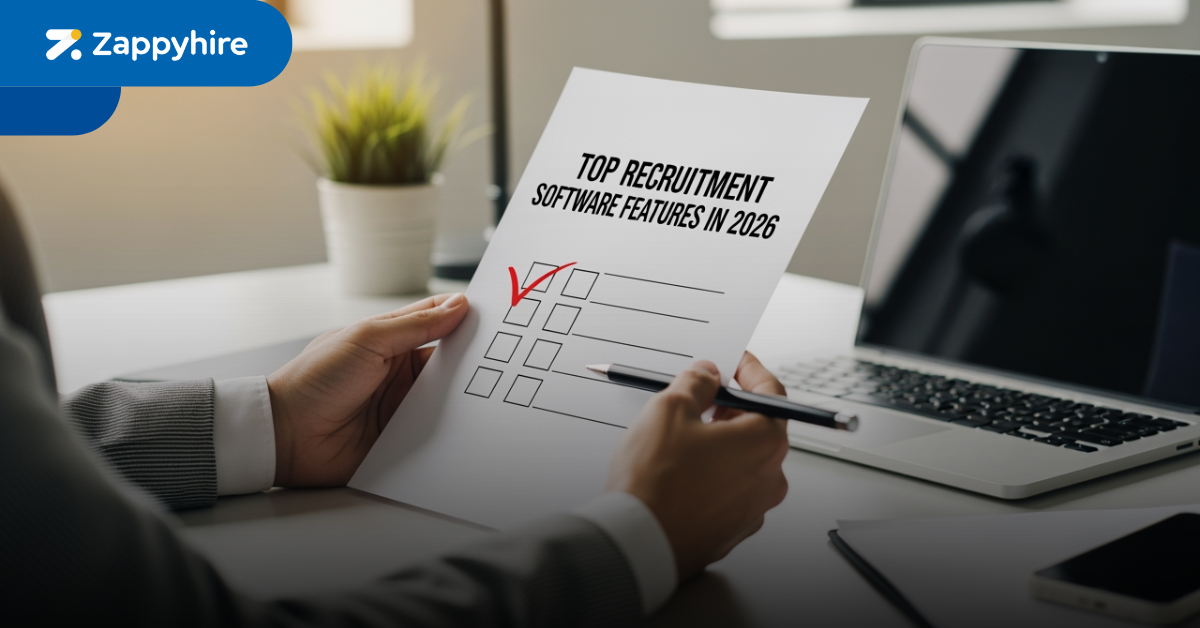
“Every battle is won before it is fought,” Sun Tzu once said; and in enterprise recruitment, having the right process and tools is that pre-battle strategy that wins the war for talent.
What is enterprise recruitment?
Enterprise recruitment is the strategic process of hiring at scale – it’s how large organizations attract, assess, and onboard talent across multiple roles, departments, and often geographies.
Unlike a small business hiring one role at a time, enterprise recruitment involves managing high volumes of candidates and coordinating numerous stakeholders under a unified strategy.
This makes recruitment software for enterprise not just helpful, but essential for modern hiring teams.
What are the challenges and difficulties in enterprise recruitment?
As per a recent survey, 74% of enterprise companies are struggling to find qualified candidates.
Even more concerning? 60% of companies saw their time-to-hire increase in 2024, meaning critical roles are left unfilled for longer periods – slowing down business momentum.
Enterprise hiring is a high-stakes, high-volume operation where speed, precision, and coordination are critical – but too often, chaos wins. Here’s why.
Too many applicants, too little time
High-volume applications can quickly overwhelm even the most seasoned hiring teams.
Sifting through thousands of resumes and scheduling interviews manually leads to delays, fatigue, and a higher chance of overlooking qualified candidates.
Talent is scarce, and highly selective
In-demand candidates are often off the market within 10 days.
When the hiring process drags on, enterprises risk losing top talent to faster-moving competitors. Speed and experience matter more than ever.
Disconnected systems, disjointed processes
Many enterprises still rely on outdated or siloed recruitment systems.
Without a recruitment system with seamless integrations or centralized visibility, teams waste valuable time switching between tools, re-entering data, and managing clunky workflows.

Decision-making bottlenecks everywhere
Enterprise hiring involves multiple layers of approvals, reviewers, and panel interviews.
This multi-step coordination often leads to miscommunication, slowed decisions, and missed opportunities.
Compliance risks keep growing
From data privacy regulations like GDPR to anti-discrimination laws, staying compliant is more complex in large organizations – especially those hiring across multiple regions.
A single misstep can cost money and reputation.
Candidate experience takes a backseat
Long response times, inconsistent communication, and tedious application processes lead to a poor experience and in turn, hurt your employer brand.
When candidates feel lost in the system, they’re more likely to drop out or decline offers.
Scaling without chaos feels impossible
Hiring for hundreds or thousands of roles across departments demands consistency. But without automation and standardization, scaling recruitment often results in process breakdowns and poor hiring outcomes.

So, what exactly does enterprise recruitment consist of? Let’s break down the enterprise hiring process, see how it differs from regular recruitment, and explore how scalable recruitment automation solutions can address common pain points for enterprises.
How is enterprise recruitment different from regular recruitment?
Enterprise recruitment isn’t just hiring at a bigger scale – it’s hiring with bigger stakes.
| Aspect | Regular Recruitment | Enterprise Recruitment |
|---|---|---|
| Hiring Goal | Fill a few roles quickly. | Align talent with long-term business goals and hire at scale. |
| Approach | Match resumes to job descriptions. | Strategically align candidates with role expectations and organizational culture. |
| Scale | A handful of open positions. | Often hundreds of roles across geographies and departments. |
| Candidate Journey | May involve basic tools or manual steps. | Needs automation for handling bulk applications and delivering a consistent candidate experience. |
| Technology Needs | Spreadsheets, emails, or basic ATS. | Robust recruitment automation platforms with AI-driven screening and workflow customization. |
| Margin for Error | Mistakes may be manageable. | One bad hire can impact teams, budgets, and brand reputation. |
| Decision-Making | Often led by a recruiter or hiring manager. | Involves multiple stakeholders—HRBPs, CHROs, legal, and hiring managers. |
| Compliance & Governance | Fewer layers, simpler processes. | Stringent compliance processes and audit-ready recruitment workflows. |
| Workflow Style | Relies on speed, intuition, and hustle. | Demands structure, repeatability, and strategic finesse. |
| Stakeholder Collaboration | Limited to a few conversations. | Ongoing coordination across departments and functions. |
| Why Automation Matters | A nice-to-have. | A necessity for scalability, precision, and a strong employer brand. |
| Recruitment Software Role | Might not always be used. | Central to managing speed, scale, structure, and data-driven decisions across the hiring funnel. |
What does the enterprise hiring process consist of?
The enterprise hiring process encompasses all the stages of recruiting at a large organization, from initial planning to bringing a new hire on board.
While every company’s workflow may vary, a typical enterprise recruitment process includes the following steps.
1. Workforce planning & requisition
It starts with identifying hiring needs across the company.
HR and department leaders forecast talent requirements and create job requisitions. In a big company, this often involves multiple approval layers to ensure each hire aligns with business goals and budgets.
Clear planning at this stage prevents ad-hoc recruitment and ensures the organization is prepared to scale teams when needed.
2. Sourcing candidates
Enterprises cast a wide net to find candidates. This includes posting on job boards and career sites, leveraging employee referrals, engaging recruiting agencies, and tapping into talent pools or campus recruitment.
Large firms also prioritize employer branding during sourcing – a strong brand and candidate outreach strategy are crucial when hiring at scale, as top talent often has many options.
3. Screening and shortlisting
Given the high volumes of applications large enterprises receive, efficient screening is critical. Recruiters use criteria (skills, experience, etc.) to filter resumes, often with the help of an Applicant Tracking System (ATS) or AI tools for resume parsing.
The goal is to quickly shortlist the most qualified candidates. (On average, a single online job posting can attract 250+ applications, yet only a handful will typically advance to interviews, highlighting the need for robust filtering at this stage.)
4. Interviews and assessments
Enterprise recruitment processes consist of multiple interview rounds.
The interview process is more structured which includes: HR screenings, technical or functional interviews with hiring managers, panel interviews for cultural fit, and sometimes assessment tests or case studies.
Coordination is complex – scheduling across busy calendars and time zones – and maintaining a positive candidate experience during potentially lengthy interview stages is of utmost importance.
5. Decision and offer management
Hiring decisions in enterprises usually involve consensus among several stakeholders (hiring managers, team leads, HR, and sometimes higher executives). Once a candidate is selected, the organization extends a formal offer.
Enterprises often have standardized compensation frameworks and approval workflows for offers, ensuring fairness and compliance.
This stage may include negotiations and requires swift communication to secure the candidate.
6. Background checks and onboarding
Before the new hire joins, an enterprise hiring process would involve conducting thorough background checks (employment verification, reference checks, etc.), especially for roles with high responsibility or in regulated industries. Onboarding is then organized to integrate the new employee.

Large organizations typically have formal onboarding programs (documentation, training, orientation sessions) to help new hires navigate corporate structure and culture from day one.
Each of these steps must be executed at scale and with consistency. When it comes to enterprise recruitment, hundreds of requisitions might be open at once, and recruiters could be screening thousands of candidates in parallel.

To illustrate the scale, India’s largest automobile manufacturer once received over 26,000 applications in a blue-collar recruitment drive, resulting in 1,200 hires – all within a single hiring cycle.
How is high-volume hiring made easy with enterprise recruitment software?
Coordinating an enterprise-scale hiring process is a complex undertaking – one where enterprise recruitment software has become a must. These platforms (often encompassing advanced ATS and talent acquisition suites) act as enterprise hiring solutions that streamline and automate the recruitment lifecycle end-to-end.
In fact, it’s telling that nearly 99% of Fortune 500 companies use an ATS to manage recruitment. But modern enterprise recruiting solutions go beyond basic applicant tracking. Here’s how they add value:
Centralized talent pipeline
Enterprise recruitment software provides a single source of truth for all candidate data and hiring activities. Instead of juggling multiple tools or spreadsheets, recruiters and hiring managers collaborate on one platform, from requisition to offer.
This centralization prevents data silos.
Automation & AI assistance
Leading enterprise recruiting solutions incorporate AI and automation to handle repetitive or high-volume tasks. Resume screening can be done in seconds with intelligent parsers; chatbots can answer candidate FAQs and pre-qualify applicants; and scheduling tools automate interview coordination.
This drastically accelerates hiring as 86% of recruiters say their ATS has reduced time-to-hire for their organization.
Data-driven insights
At an enterprise level, optimizing recruitment requires good analytics. Recruitment software offers dashboards and reports on key metrics – time-to-fill, time-to-hire, source of hire, candidate drop-off rates, diversity stats, and more. These insights help talent acquisition leaders identify bottlenecks and refine their strategy continuously.
For example, if data shows that time-to-hire is creeping up for certain roles, the team can investigate and intervene.
Similarly, tracking conversion rates at each funnel stage can highlight if too many candidates are dropping out due to a lengthy process or poor experience.
With data in hand, enterprises make more informed decisions to improve hiring outcomes.
Enhanced candidate experience
Enterprise recruitment software doesn’t just help the recruiters – it also creates a smoother journey for candidates. Features like mobile-friendly career portals, one-click apply, automated status updates, and chat support keep candidates engaged and informed.
This is vital, because candidate drop-off can be a serious issue: an estimated 92% of job seekers never complete their online job applications (often due to cumbersome processes).

Scalability and integration
Any software adopted at the enterprise level must scale and fit into the existing tech ecosystem.
They should be able to integrate with other HR and IT systems (HRIS, payroll, assessment tools, etc.), ensuring a seamless data flow from recruiting to onboarding and beyond. Notably, enterprise-grade recruitment platforms often allow customization to align with a company’s established processes.

One leading bank in India chose an AI-driven hiring platform that adapted to their existing hiring process, bringing all stakeholders onto one system without forcing process changes.
In short, the software should meet the enterprise where it is – enhancing rather than disrupting the existing recruitment workflow.
An ideal enterprise recruitment process should be a well-oiled operation.
Even the most ambitious hiring goals can fall flat without the right foundation. It’s not about chasing the newest trends or adding tools for the sake of it. It’s about finding what brings structure to the scale, and purpose to the process.
Because at the end of the day, behind every metric, dashboard, or hiring funnel… there’s a human story waiting to begin.






